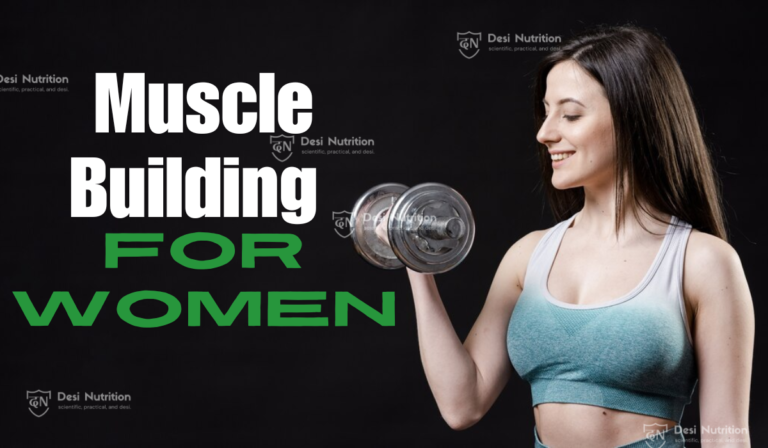Building muscles has numerous benefits. Since decades this domain has been dominated by men but now women are also in the front of this domain. This article is a comprehensive guide of muscle building for women.

Muscle building is not about trends or showing people women can do anything (of course they can), but it is more about empowerment, overall health and longevity. Strength training has numerous benefits that women should also enjoy. From improved metabolism to fat loss to better mental health you will experience an increased strength in your body to carry on your daily activities.
To understand muscle building for women, you need to understand the science behind muscle growth when it comes to women, so let’s start with our first section:
The science behind muscle building:
Muscle growth has a science behind it. Understanding the concept will also help you to understand your body better and how it works. Muscle strength and gain is the result of resistance training. When you let your muscles undergo resistance training they face microscopic tears and damage. The muscles then repairs themselves leading to an increase in muscle sizes. This process is also called hypertrophy and includes several elements like:
Resistance training:
Resistance training includes exercises that provide stimulus for muscle growth. These exercises involve exposing your muscles to a load such as weight that will act as an external force for your muscle fiber to tear at microscopic levels. These tears and damage are repaired when your body gets adequate rest which results in stronger and larger muscles.
Protein synthesis:
Muscle growth is also the result of protein synthesis exceeding protein breakdown which is facilitated by the consumption of adequate protein and also by engaging in regular strength training exercises.
Hormones:
Hormones play a vital role in muscle building. Testosterone, growth hormone, and insulin plays a role in muscle building because strength training changes how they respond. Though women have low testosterone levels they can still build muscles with a strategic approach.
Nutrition for muscle building

Nutrition plays a crucial role in muscle building. You need to focus on nutrition so your body can repair and grow muscle tissues effectively. Here is a breakdown of important nutrients that you need not just for muscle building but also for your overall health.
Protein:
You need to consume protein in your diet because they are the building blocks of your muscles. When your muscle tissues undergo micro tears they repair themselves with the help of protein. Add protein sources like lean meats, fish, eggs, diary, legumes and plant-based protein products like tofu and tempeh.
Carbohydrates:
Ensure to include complex carbohydrates in your diet. They are the primary source of energy which also help to replenish glycogen stores in muscles. Include complex carbohydrates sources like whole grains, fruits and vegetables in your diet.
Fats:
The last of the three essential macronutrients, fats are crucial because they help in the production of hormones. Healthy fat sources like avocados, nuts, seeds and olive oil should be your priority to add in your diet for muscle gain.
Caloric intake:
In order to gain muscle, you need to consume more calories than you burn because you need to create a caloric surplus. Ensure to consume more calories than you burn but that does not mean you do not track your overall calorie consumption.
Hydration:
Hydration is one the most important elements to achieve any health goal. An adult human body is made of 50-60% water. In order to meet the requirements of the body you need to keep yourself hydrated. But there are other benefits of drinking water throughout the day. Water aids in weight loss by making you feel full and it also helps in nutrient transportation, joint lubrication and temperature regulation.
Effective training techniques

You will strengthen your muscles by doing exercises which support muscle building. Using a resistance against your muscles will help to strengthen muscles. Here is a list of effective training techniques to build muscles:
Compound movement:
Compound movements include exercises that target multiple muscle groups at the same time. Include compound exercises like squats, deadlifts, bench press, and pull-ups. These exercises help to improve overall strength and muscle growth.
Progressive overload:
You need to challenge your muscles continuously. Ensure to progressively increase the resistance on your muscles for continuous growth and strength. Increase the weight gradually along with increasing the sets and reps in your workouts.
Volume and frequency:
Volume and frequency of the exercises also influence your results. If you want effective results ensure to take proper rest in between your strength training sessions. You need to exercise 3-4 sets per exercise with 8-12 repetitions. Focus on training each muscle group 2-3 times per week which is effective for muscle growth.
Rest and recovery:
Rest is your priority in muscle building. When you indulge in strength training your muscle tissues undergo microscopic damages and tears which need to be repaired. Your body needs time to recover itself; that is why you need to prioritize rest. Sleep is the best way to make certain that your body gets an adequate amount of rest. Aim to sleep for 7-9 or 8-10 hours per night to recover and heal your body. Appropriate amount of sleep helps to maintain your weight and keep you stressed free.
Common myths around muscle building for women

People often develop misconceptions and there are a few myths surrounding the topic “muscle building for women” as well. In this section let us debunk the common myths and misconceptions about the topic.
Lifting weight makes you bulky:
Usually you see men lifting weight which makes them bulky but the same does not apply for women. The reason for this is the low testosterone levels in women. Testosterone is the hormone responsible for bulk; since women have lower levels of this hormone they are less likely to gain muscle mass at the same rate as men. You will definitely get a toned body and witness an increase in strength.
Only do high reps and light weights:
If you want to enhance muscular endurance then yes, high reps and light weight is your option but is not not an effective way to build muscle. You need to incorporate heavy weight with moderate reps to support hypertrophy.
Train like a man to build muscle:
Women are told they would have to train like a man to build muscle. But do not pay attention to wherever you have heard or read this. Though muscle-building principles are the same for both men and women, you will get a tailored workout plan that compliments your personal health goals. Train based on your personal objectives.
Muscle turns into fat if I stop training:
Muscles and fats are two different tissues and your muscle will not turn into fat if you stop training. You might lose muscle mass though, but it won’t turn into fat. Focus on exercising and proper nutrition to manage body composition.
Overcoming challenges
A woman would face challenges while building muscles but it shoul;n’t stop you from achieving your goals. Address those challenges and overcome them with the help of a well-strategized approach.
Consistency:
Consistency is the key to get effective results and achieve your health goal of muscle building. To make certain that you follow muscle building regimen you need to set some realistic goals, establish a routine and track your progress. Celebrate small victories so you can stay motivated throughout.
Overcome plateaus:
You will experience plateaus in your muscle building journey because they are a natural part of the process. Whenever you face such a situation you need to focus on increasing weights, changing exercise or improving your diets. Making changes in your current approach can help you overcome plateaus.
Muscle soreness:
Muscle soreness is also common when training your muscles. You will be uncomfortable especially if you are a beginner but it’s a good sign that your muscles are adapting to the new stimuli. To overcome soreness you should include low-intensity cardio, especially walking. Focus on rest, recovery, hydration and proper nutrition to alleviate soreness.
Balance cardio and strength training:
You need to include both cardio and strength training in your workout for muscle building., they both will help you gain muscle required you approach both in a balanced way. Include 2-3 cardio sessions in a week or include moderate intensity cardio in every session of your strength training.
Tailoring your exercising approach:
Your body is different from any other man or a woman. Though the basics of strength training remains the same for everyone, the exercise routine should be tailored according to personal objectives.
Fat loss and muscle gain:
You can gain muscle and lose weight simultaneously by choosing the right approach for your health goal. Incorporating high-intensity interval training will help you to achieve the goal of gaining muscle and losing fat simultaneously.
Building muscle without gaining fat:
If your goal is to gain muscle without gaining fat you should aim for lean bulk. Lean bulk means creating a slight caloric surplus by emphasizing on nutrient-dense food to support your health goal and overall health.
Age-related considerations:
With age muscle mass usually declines among women. To maintain muscle mass, women after 40 years of age should focus on regular resistance training, adequate nutrition by protein intake and joint-friendly exercises.
Frequently Asked Questions
How long does it take for women to build muscle?
Ans. Women could start seeing results in their muscle structure within 8 weeks of exercising and within 12 weeks you witness visible muscle growth.
Do muscles grow on rest days?
Ans. When you exercise using a resistance against your muscles, they experience microscopic tears and damage. It is the rest of the days that ensure your muscle tissues recover. The muscle tissues repair itself and grow back stronger.
How much sleep is needed for muscle growth?
Ans. Women need to sleep for 7-9 hours allowing your body to take adequate rest for muscle growth.




